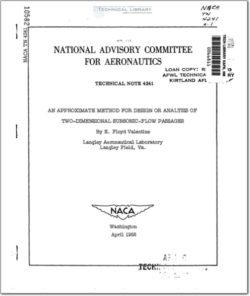NACA-TN-4241

- Version
- 134 Downloads
- 1.65 MB File Size
- 1 File Count
- December 4, 2015 Create Date
- December 4, 2015 Last Updated
National Advisory Committee for Aeronautics, Technical Notes - An Approximate Method for Design and Analysis of Two-Dimensional Subsonic Flow Passages

A method has been developed for the design and analysis of two—
dimensional subsonic-flow passages with isentropic nonviscous flow. The
method is based on the relation between the pressure change across a
stream tube and the centrifugal force resulting from the curvature of the
flow. Precomputed charts can be drawn which eliminate subsequent calcu-
lation for a given upstream.Mach number. The method is limited by the
accuracy with which the radius of curvature of the streamlines can be
determined.
In an example the method was applied to the design of an expanding
elbow at each of two Mach numbers. Two elbow contours and their surface
pressure distributions were obtained.
Much experimental work on internal-flow systems has consisted of
tests of more or less arbitrarily laid out duct components to determine
regions of separated flow, pressure losses, and flow distortion at the
exit. This research could be conducted in a more effective manner if a
method were available to design some of these duct components to avoid
regions of local speedup and steep adverse pressure gradients. Further—
more, if the flow in existing components could be analyzed, the analysis
would furnish a basis for comparison of ideal and actual performance and
could be used as a basis of elimination of unpromising components from
an experimental program.
Several methods for analyzing the flow in subsonic duct systems are
available. Flfigel's stream-filament method discussed in reference 1 was
utilized in references 2 and 5 by making arbitrary assumptions about the
variation of the radius of curvature. The method was used in reference h
for the analysis of the flow in three-dimensional passages and in refer-
ence 5 for the design of three-dimensional passages. A wire-mesh plotting
device for incompressible flow is described in reference 6, and in
reference 7 a device consisting of cams combined with a wire mesh is
described which is applicable to compressible flow.
In the present report a method is developed for the design and anal-
ysis'of two-dimensional subsonic—flow passages with isentr0pic nonviscous
flow. The method parallels the three-dimensional treatment of refer-
ences h and 5. Restriction of the treatment to two-dimensional-flow prob-
lems permits the use of precomputed charts from which the values required
can be read directly. Ehe charts can be used for design or analysis of
flow passages with the assumption of isentropic, subsonic, nonviscous
flow.
| File | Action |
|---|---|
| naca-tn-4241.pdf | Download |

Comment On This Post